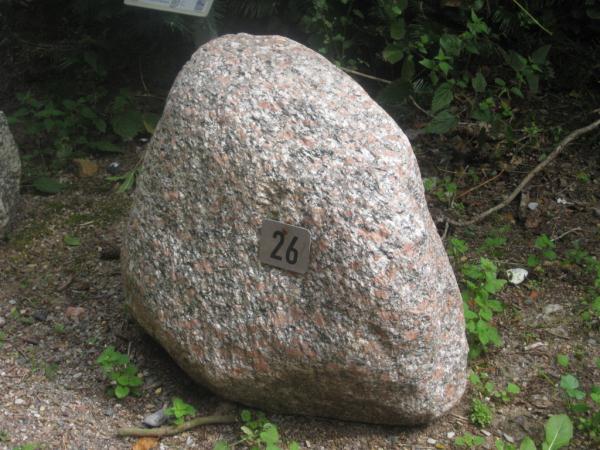Usedomer Findlinge EarthCache
-
Difficulty:
-

-
Terrain:
-

Size:  (not chosen)
(not chosen)
Please note Use of geocaching.com services is subject to the terms and conditions
in our disclaimer.
[EN]
Huge erratic boulders, rocks and stones were picked up by the ice
sheets during the Ice Age and were transported from Scandinavia to
the current island of Usedom. Significant stones can be gazed at
the impressive stone garden of Pudagla.

The third and last Ice Age of Scandinavian, named
„Weichselvereisung“ left the typical landscape of
Mecklenburg-Vorpommern after deglaciation. The island of Usedom
was built by moraines of stones, clay, sand and marl till an
altitude of 100 meters. These sedimentations built a geological
barrier to prevent the overflow of the Baltic Sea across
Mecklenburg-Vorpommern. The landscape of Achterwasser and the
former Pudagla Gap make it easy to see the former glacier.
Gigantic ice sheets from the West of Finland and from the North
of Sweden flowed to the area of the island of Usedom. The
enormous ice sheets deformed the Earth's crust and mantle.
Ablated, pressed, broken and pulverized mountains were
transported up to 1000km by ice-rafting.
Comparative work with erratic boulders and rocks from Scandinavia
makes it possible to locate the original areas in the north. On
closer examination the stone collection there struck different
colours and mineralogical composition. That depends on the
different date of origin. During a walk through the exhibition
granites, basalts, sandstones, limestones, gneiss and
quartzite from different origin areas can be discovered.
The trained view after visit the stone garden will show visitors
many of erratic boulders all over the whole island of Usedom. All
this boulders and rocks are constitutionelly protected by
Conservation of Nature and of Landscape Act ,
Mecklenburg-Vorpommern.
To log this earthcache, send me an email with answers to the
following questions:
What is the name of the city in the North of Sweden where the
northernmost erratic boulder of this exhibition comes from ( ca
1000km air line)?
What is the name of gneiss which connects on a sense organ of human
being?
Name the division into 3 groups when stones are formed by history
of origins.
I would be glad about a foto of you in the stone garden of Usedom.
(optional)
I wish you enjoy to discover the interesting surrounding
area!
[DE]
Während der Eiszeit wurden riesige Findlinge von mächtigen
Gletschern aus Skandinavien auf das heutige Usedom transportiert.
Im beeindruckenden Gesteinsgarten von Pudagla können diese
aussagekräftigen Steine bestaunt werden.
Die dritte und jüngste Eiszeit vor 10.000 Jahre v.d.Z. im
skandinavischen Raum, genannt Weichselvereisung, hat nach
dem Abschmelzen eine einmalige Landschaft in Vorpommern
hinterlassen. Die Insel Usedom wurde durch Moränen aus Gesteinen,
Lehm, Sand und Mergel mit einer Höhe von bis zu 100 Metern
gebildet. Diese Ablagerungen verhindern die Überflutung von
Mecklenburg-Vorpommern durch die Ostsee. Weitere Zeugen sind die
Ausformung des Achterwasser oder die ehemalige Ausformung der
Pudaglapforte.
Die riesigen Eismassen Westfinnlands und Nordschwedens flossen in
das Gebiet der Insel Usedom. Gebirge wurden abgetragen,
durch gewaltige Eiskörper gepresst, zerbrochen und zerrieben und
durch die gewaltigen Eismassen zum Teil 1000km
mittransportiert.
Vergleichende Arbeit der Findlinge mit Gesteinen aus Skandinavien
machen es möglich ihre Herkunftsgebiete gut zu lokalisieren. Beim
genauen Betrachten der Gesteinssammlung fallen die vielfältigen
Farben und Zusammensetzungen auf, diese hängen mit der
unterschiedlichen Entstehungszeit der Gesteine zusammen. Bei einem
Spaziergang durch die Ausstellung können Granite, Basalte,
Sandsteine, Kalksteine, aber auch Gneise und Quarzite
verschiedenster Herkunft entdeckt werden.
Der, durch die Ausstellung geschulte Blick, wird fortan auf der
gesamten Insel Findlinge entdecken. Sie sind durch das
Landesnaturschutzgesetz von Mecklenburg-Vorpommern zum
geschützten Landschaftsbestandteil erklärt worden.
Für die Logerlaubnis dieses Earthcaches beantworte die
folgenden Fragen:
Wir heißt der nördlichste Herkunftsort eines hier ausgestellten
Findlings in Nordschweden (rund 1000km Luftlinie) ?
Wie nennt man das Gneisgestein, dessen Bezeichnung mit einem
Sinnesorgan des Menschen in Zusammenhang steht?
In welche drei Großgruppen lassen sich die Steine nach ihrer
Entstehungsgeschichte einteilen ?
Besonders würde ich mich über ein Foto von Dir im Gesteinsgarten
freuen.
Viel Freude beim Erkunden und Entdecken!
Quelle: Folder, Usedomer Gesteinsgarten in Ückeritz
Additional Hints
(No hints available.)